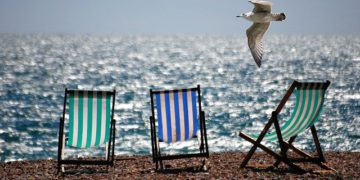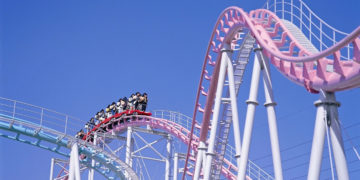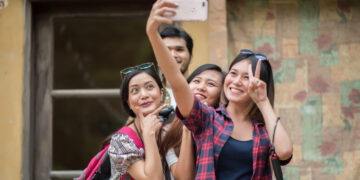Last Updated on 1 week by admin
Wondering what to do during winter in Korea? From snowy landscapes to winter sports, there’s no shortage of activities to keep you engaged.
Wondering what to do during winter in Korea? From snowy landscapes to exciting winter sports, there’s no shortage of fun activities to keep you entertained while staying warm. Whether you’re visiting for the first time or are a returning traveler, here are some of the best winter experiences in Korea to make your trip unforgettable.
Winter Activities in Korea: Must-Try Experiences for a Memorable Season
Visit a Magical Winter Theme Park
Korea’s theme parks transform into winter wonderlands during the colder months, offering festive parades, sparkling illuminations, and family-friendly activities like sledding and snowball fights. It’s a perfect spot for making memories and capturing stunning photos. Top winter-themed parks to visit include:
- Everland Resort
- Lotte World Adventure Seoul
- One Mount Snow Park, Seoul
- Lotte World Busan
Relax in a Korean Sauna (Jjimjilbang)
There’s no better way to beat the cold than by warming up at a Korean sauna, known locally as jjimjilbang. These traditional spas feature hot baths, steam rooms, and communal relaxation areas. You’ll find two main sections:
- The Bathing Area – Enjoy a hot soak (gender-segregated).
- The Relaxation Area – Meet friends and family in cozy pajamas to unwind.
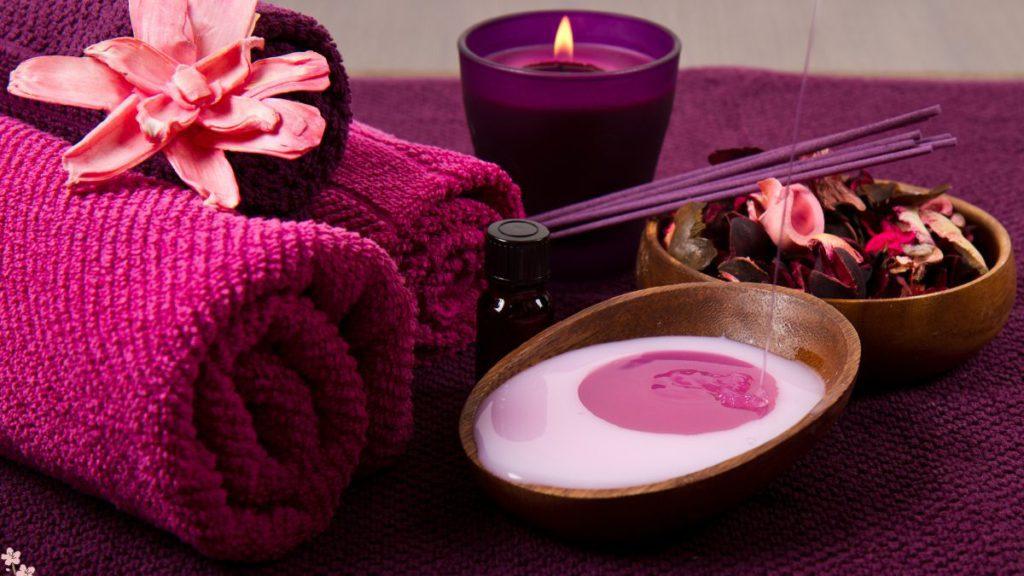
For a unique experience, visit Onyang Hot Springs in Asan City, Korea’s oldest hot spring with over 600 years of history. For luxury spa lovers in Seoul, try the O Hui and Whoo Spa for ultimate pampering.
Go Ice Skating in Seoul
Ice skating is a classic Korean winter activity, with both indoor and outdoor rinks opening from December to February. A favorite spot is the Seoul Plaza Ice Rink near City Hall, where you can skate outdoors with a festive winter atmosphere. Here are some of the best ice skating rinks in Korea:
- Mokdong Ice Rink (Seoul)
- Lotte World Ice Rink (Seoul)
- Grand Hyatt Ice Rink (Seoul)
- Yeouido Hangang Park Ice Skating Rink (Seoul)
- Seonhak International Ice Rink (Incheon)
- Shinsegae Centum City Rink (Busan)
- Daejeon Expo Plaza Ice Rink (Daejeon)
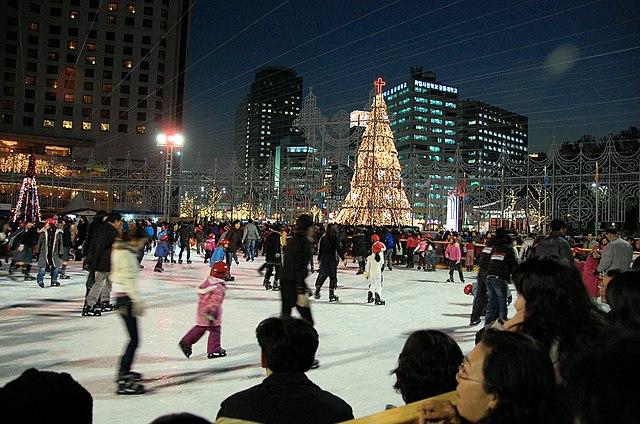
Winter Sledding at Han River
Sledding is a family-friendly activity in Korea, and Seoul’s Ttukseom Hangang Park offers exciting slopes for all ages. Another great spot is Jamwon Hangang Park, which features gentle slopes perfect for children under six. It’s an ideal introduction to winter sports for young visitors.
Pick Sweet Korean Strawberries
Winter is strawberry season in Korea, and you’ll find some of the sweetest, freshest strawberries in markets across the country. For a fun activity, visit a strawberry farm to pick your own! Combine strawberry picking with other winter tours, such as visiting the Garden of Morning Calm or Pocheon Art Valley.
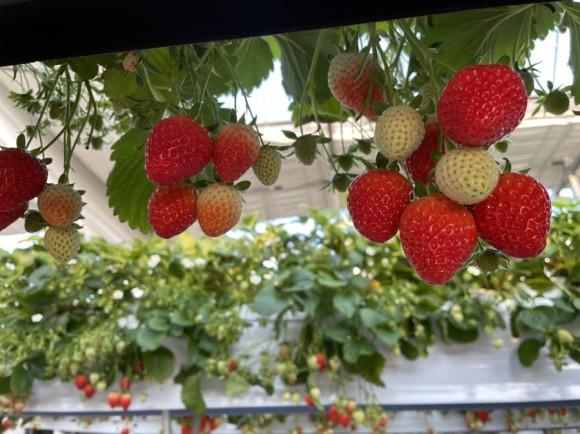
Explore Korea’s Coffee and Tea Culture
Winter is the perfect time to cozy up in one of Korea’s many coffee shops. With over 75,000 cafes nationwide, you can experience Korea’s unique coffee culture in popular spots like Bukchon Hanok Village or coastal cities like Gangneung, famous for its Coffee Street and annual coffee festival. Prefer something traditional? Visit a Korean tea house for a warm cup of delicate herbal tea while relaxing in a serene, hanok-style setting.
Take a Walk in the Snow
There’s nothing quite like a walk through Korea’s historic cities when snow begins to fall. The snow-draped rooftops of Bukchon Hanok Village, ancient palaces, and fortress walls in places like Gyeongju and Andong offer breathtaking views during winter.For a peaceful stroll, explore Seoul’s scenic walking trails or the quiet neighborhoods lit up with soft winter lights.
Ski Resorts and Winter Sports in Korea
Korea’s ski season runs from December to February, and its many mountains offer world-class ski resorts perfect for snow sports enthusiasts and beginners alike. Most ski resorts are located in Gyeonggi and Gangwon Provinces, just a short drive from Seoul.
Top Ski Resorts in Korea
- High 1 Ski Resort: Known for its extensive slopes and stunning mountain scenery, this resort offers options for all skill levels.
- Vivaldi Park Ski Resort: One of Korea’s most popular resorts, with modern facilities, 12 slopes, and the family-friendly Snowy Land play area.
- Jisan Forest Ski Resort: A compact, forested resort with beginner slopes, a sledding park, and a ski school.
- Alpensia Ski Resort: A 2018 Winter Olympics venue offering a mix of slopes for all abilities.
- Elysian Gangchon Ski Resort: Perfect for skiing, snowboarding, and sledding, with scenic hiking trails nearby.
- Yongpyong Ski Resort: A premier resort with 28 slopes, ideal for experienced skiers and snowboarders.
- Eden Valley: Located near Busan, this resort is ideal for southern visitors and offers slopes for all levels.
Ski Resort Tours and Packages
For a hassle-free winter sports trip, consider booking a ski tour that includes transportation, equipment rental, and accommodation. Many resorts offer overnight packages, allowing you to enjoy a magical sunrise over the snowy peaks—an experience not to be missed!
Winter Festivals in Korea 2025
Korea transforms into a magical winter wonderland during the colder months, offering vibrant festivals filled with lights, snowy landscapes, and cultural traditions. Whether you’re admiring stunning illuminations, catching fish through frozen lakes, or watching the year’s first sunrise, here’s a guide to some of the best winter festivals in Korea for 2025.
Winter Illumination Festivals 2025
When the sun sets, Korea’s winter illumination festivals light up the night with dazzling displays. Popular spots like Seoul’s Cheonggyecheon Stream and Busan’s Haeundae Beach come alive with millions of glowing lights, creating unforgettable winter scenery. Here are some must-visit illumination festivals:
- Garden of Morning Calm Winter Illuminations
- Dates: December 5, 2025 – March 15, 2026
- Location: 경기 가평군 상면 수목원로 432
- Herb Island Light Festival
- Dates: Year-round
- Location: 경기 포천시 신북면 청신로947번길 51
- Busan Christmas Tree Cultural Festival
- Dates: December 5, 2025 – February 22, 2026
- Location: 부산 중구 광복로 72-1
- Jeju Light Garden Festival
- Dates: Year-round
- Location: 제주 제주시 애월읍 평화로 2346
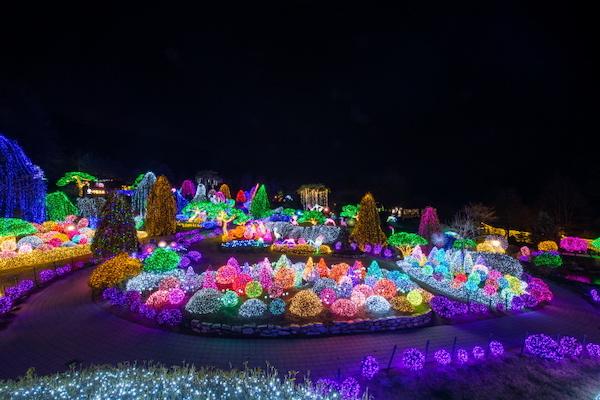
Ice Fishing Festivals 2025
Winter in Korea means frozen rivers and lakes, making it the perfect time for ice fishing. These festivals combine fishing through the ice with fun activities like sledding, hand-catching fish, and snow sculpting. Top ice fishing festivals include:
- Hwacheon Sancheoneo Ice Fishing Festival
- Dates: January 10, 2026 – February 1, 2026
- Location: 강원 화천군 화천읍 중리 187-15
- Pyeongchang Trout Fishing Festival
- Dates: December 27, 2024 – February 2, 2025 (2026 – TBA)
- Location: 강원 평창군 진부면 하진부리 1289-80
- Inje Ice Fishing Festival
- Dates: TBA
- Location: 강원 인제군 남면 부평리 555-2
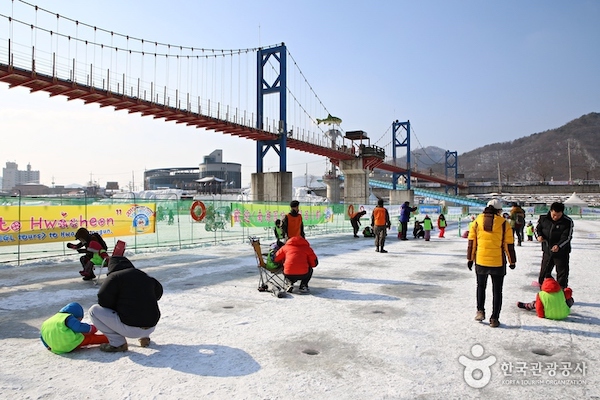
Snow and Ice Festivals 2025
Gangwon Province, known for its cold and snowy winters, is home to some of the best snow festivals in Korea. At these events, you’ll see ice sculptures, snowy trails, frozen waterfalls, and winter sports. Must-visit snow and ice festivals:
- Chilgapsan Ice Fountain Festival
- Dates: Dec 2025 – Feb 2026
- Location: 충남 청양군 정산면 천장리 226-35
- Taebaeksan Mountain Snow Festival
- Dates: Jan – Feb 2026 (TBA)
- Location: 강원 태백시 태백산로 4834-31
- Daegwallyeong Snowflake Festival
- Dates: Jan – Feb 2026 (TBA)
- Location: 강원 평창군 대관령면 사부랑길 224-2
New Year’s Eve Festivals
New Year’s Eve in Korea combines tradition with modern celebrations. At midnight, many people gather to hear the ringing of a giant bell to welcome the new year, while others enjoy spectacular fireworks displays across the country.
- Bosingak Bell-Ringing Ceremony (Seoul): Join the crowd at Bosingak Pavilion to witness the giant bell ring at midnight.
- Lotte World Tower Fireworks: Watch an incredible fireworks display over Seoul’s skyline.
- Han River Fireworks: Enjoy the festive celebrations near Yeouido Park and City Hall Station.
Fireworks can also be seen along beaches and coastal areas, offering a perfect way to celebrate the New Year.
New Year’s Day Sunrise Festivals 2026
Watching the first sunrise of the year is a popular tradition in Korea. Coastal towns host sunrise festivals where visitors gather to reflect, enjoy rice cake soup, and witness the first light of the new year.
- Homigot Sunrise Festival
- Highlight: Located at Korea’s easternmost point, Homigot is the first place to see the sunrise. Don’t miss the iconic Hand of Harmony statue emerging from the sea.
- Location: 경북 포항시 남구 호미곶면 대보리
- Seongsan Sunrise Festival (Jeju Island)
- Highlight: Celebrate the New Year at Seongsan Ilchulbong, a UNESCO World Heritage Site known for its breathtaking views.
- Location: 제주 서귀포시 성산읍 성산리 78
- Gyeongpo & Jeongdongjin Sunrise Festivals (Gangneung)
- Highlight: Located near Seoul, these festivals combine coastal beauty with festive activities. Watch the sunrise, savor local treats, and enjoy the celebrations.
- Location: 강원도 강릉시 안현동 산1
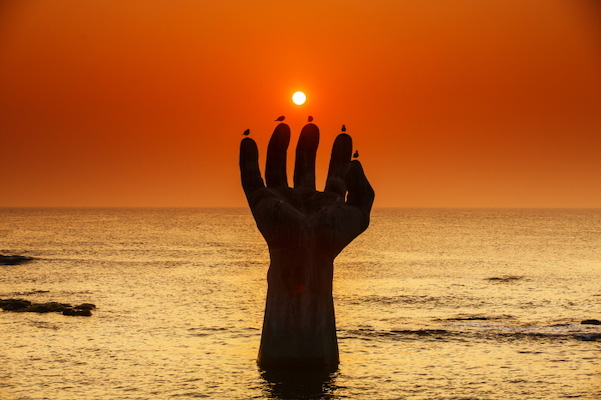
Festival Planning Tips (Dates, Tickets & Weather-Proofing)
Winter festivals in Korea are extremely popular and often weather-dependent. Festival schedules can shift year to year, so always double-check the official website before traveling.
Helpful tips:
- Book tickets early for light festivals and illumination events
- Dress extra warm — many events run outdoors at night
- Check cancellation policies in case of severe weather
- Arrive early during weekends to avoid long lines or limited parking
Winter Sightseeing in Korea: Discover Korea’s Magical Winter Landscapes
Winter in Korea offers stunning sights and unique experiences that are equally, if not more, beautiful than other seasons. With clear blue skies, snow-dusted palaces, frozen forests, and charming illuminations, it’s a fantastic time to explore. Here’s a guide to the best winter sightseeing spots in Korea, ensuring unforgettable moments during your cold-weather adventures.
1. Seoul’s Royal Palaces
Seoul’s royal palaces, such as Gyeongbokgung Palace, are breathtaking year-round but become magical under a blanket of snow. The rooftops glisten with snow, frozen ponds reflect the icy skies, and the walls provide a vibrant contrast to the white surroundings. It’s an ideal setting for a hanbok photoshoot or for simply enjoying Korea’s historic beauty.
2. Garden of Morning Calm
The Garden of Morning Calm transforms into a glittering wonderland in winter, thanks to its famous light festival. At night, the gardens glow with colorful illuminations that wind through hanok houses, serene ponds, and scenic pagodas. It’s a perfect day trip from Seoul.
3. Jogyesa Buddhist Temple
Temples in Korea exude a peaceful charm during winter, with Jogyesa Temple in Seoul being particularly accessible. Snow-draped roofs and serene courtyards offer a picturesque contrast to the bustling city. For more snowy temple scenes, visit Beopjusa Temple in Songnisan National Park or Haedong Yonggungsa Temple along Busan’s coast.
4. Lotte World Tower
For stunning panoramic winter views of Seoul, head to the Lotte World Tower. The Seoul Sky Observatory on the 117th floor offers clear views of the city, which are even more spectacular during winter’s sunny days. At night, the tower glows brightly, best admired from Seokchon Lake.
5. Wondaeri Birch Forest
Located in Gangwon Province, the Wondaeri Birch Forest becomes a snowy paradise during winter. With over 700,000 silver birch trees, it’s a dreamlike destination for a peaceful hike surrounded by white-topped trees and serene paths. It’s an unmissable escape for nature lovers.
6. Daegwallyeong Sheep Farm
Known as “The Alps of Korea,” Daegwallyeong Sheep Farm offers stunning snowy fields and a peaceful winter atmosphere. Spot sheep camouflaged against the snow and enjoy panoramic views of the surrounding mountains. Nearby Gangneung also offers cozy seaside cafes to warm up after your visit.
7. Gamcheon Culture Village
In Busan, Gamcheon Culture Village delights visitors with its colorful hillside houses and artistic murals. During December, the village hosts the Lantern Exhibition, where glowing lanterns light up the narrow streets, making it even more charming at night.
8. Jeju Island
For a winter getaway that balances mild weather and snowy peaks, head to Jeju Island. You can climb Hallasan Mountain, Korea’s tallest peak, to witness its snow-covered summit, or relax on Jeju’s sandy beaches. The island’s unique cafes, natural beauty, and volcanic landscapes make it a perfect winter destination.
Winter Hiking in Korea: Explore Korea’s Snow-Covered Peaks
Winter hiking in Korea is one of the most rewarding ways to experience the country’s natural beauty. With over 70% of Korea covered in mountains, snowy trails are always within reach, whether you’re in a bustling city like Seoul or exploring rural areas. From iconic peaks to serene forests, here’s your guide to the best winter hiking destinations in Korea, along with tips to keep you safe and prepared.
1. Hallasan National Park (Jeju Island)
As South Korea’s tallest peak, Hallasan on Jeju Island offers a unique winter hiking experience. Known for its snow-capped summit surrounded by semi-tropical landscapes, Hallasan attracts hikers looking for snowy beauty with coastal views. Reservations are required during peak hiking seasons, so plan ahead.
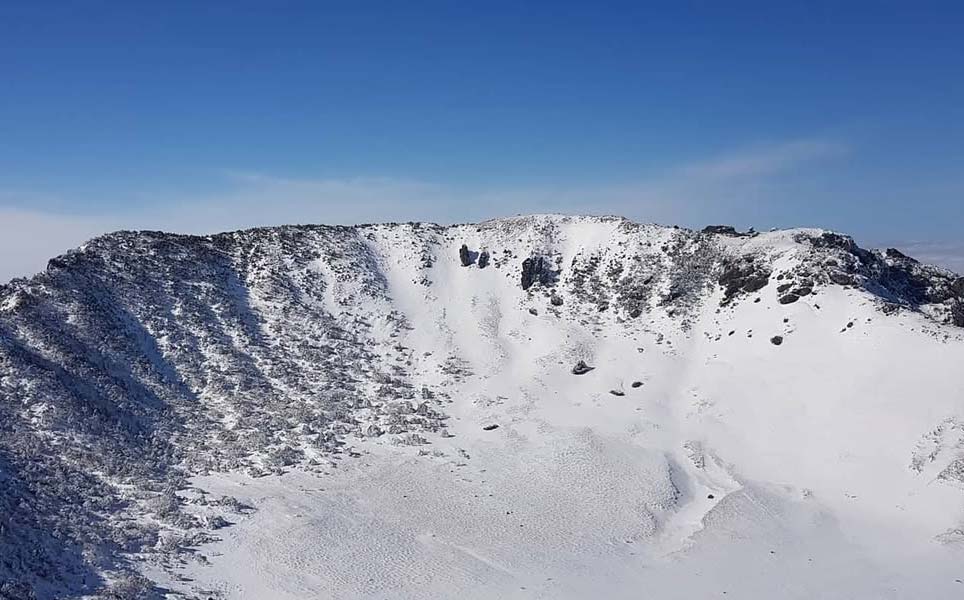
2. Deogyusan National Park
Located in central Korea, Deogyusan National Park is famous for its snow-covered valleys, beautiful mountain trails, and serene temples. The summit provides sweeping views of the surrounding peaks, while the Muju Deogyusan Ski Resort offers an alternative way down via cable car.
3. Seoraksan National Park
Seoraksan, one of Korea’s most stunning national parks, transforms into a winter wonderland with icy streams, frozen waterfalls, and pristine snow-covered peaks. The park features hiking trails of varying difficulty, as well as a cable car for visitors seeking breathtaking coastal views without the climb.
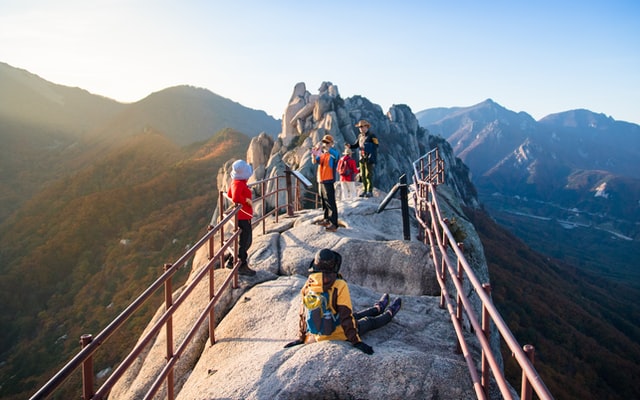
4. Jirisan National Park
As the highest peak on mainland Korea, Jirisan offers some of the best winter hiking. Adventurous hikers can stay overnight at a mountain shelter and witness a stunning sunrise from the summit. The snow-covered foothills and frozen rivers create a peaceful winter landscape worth exploring.
5. Sobaeksan National Park
Known as Korea’s “backbone,” Sobaeksan National Park offers picturesque winter scenery with panoramic views of snow-covered peaks and valleys. It’s one of the best parks for long hikes and snowy treks, with clear paths and serene forests to enjoy.
Winter Hiking Safety & Essential Preparation
Winter hiking in Korea is breathtaking — but trails can become icy, steep, and slippery. Conditions vary dramatically by elevation, especially in Seoraksan, Odaesan, and Hallasan.
- Hiking Boots: Waterproof and insulated boots are essential for snowy and icy terrain.
- Thermal Inner Wear: Base layers help keep you warm by trapping body heat.
- Wind-Resistant Jacket: A lightweight, insulated jacket that blocks wind and keeps you comfortable.
- Hat, Gloves, and Neck Warmer: Protect exposed skin to prevent frostbite.
- Crampons (Ice Cleats): Essential for traction on icy trails.
- Hiking Poles: Provide balance and stability, especially in deep snow.
- Heat Packs: Keep these in your pockets to warm your hands and feet.
- Food and Water: Carry high-energy snacks and at least 1 liter of water.
Safety Tips for Winter Hiking
- Start hikes early to avoid descending after dark
- Avoid hiking alone
- Stick to open, marked trails — some are closed in winter due to ice risk
- Check daily mountain advisories (Hallasan frequently restricts summit access)
- Be aware of strong winds at exposed ridgelines
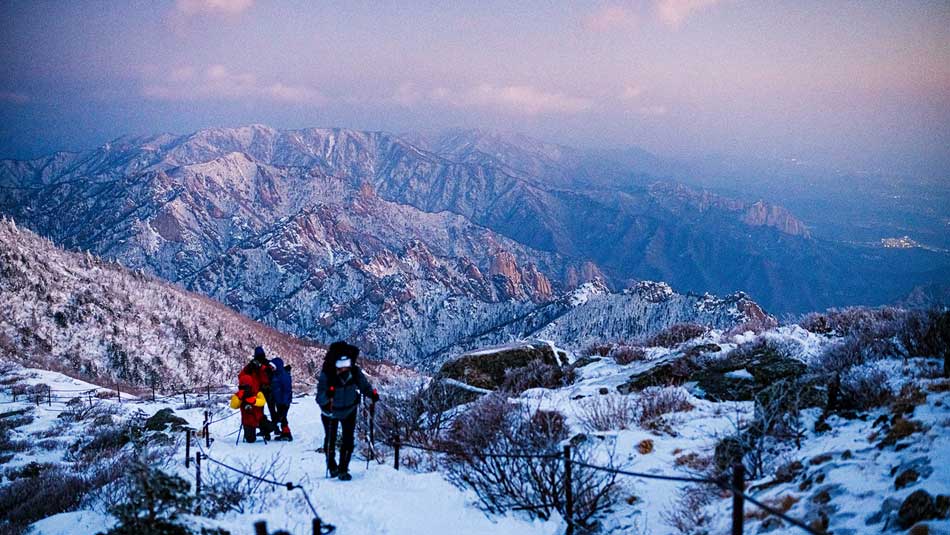
Getting Around Korea in Winter (Transport Tips)
Winter weather can affect travel times and transportation availability. While Korea’s public transit system is reliable, snow or icy conditions may cause occasional delays.
Transportation considerations:
- Trains (KTX, ITX): Usually punctual, but severe snow may cause minor delays — allow buffer time for itineraries.
- Buses: Intercity and local buses may run more slowly during snow, especially in the mountains.
- Rental cars: Roads in Gangwon Province can be icy. Use snow tires or chains (often mandatory).
- Cable cars & mountain access roads: These may temporarily close due to high winds or heavy snow. Always check before visiting.
Travel tips:
- Use apps like KakaoMap or Naver Map for live transit updates
- Keep flexible schedules on heavy-snow days
- Avoid last-minute long-distance travel during severe weather alerts
Winter Weather in Korea
- Temperature: Winter is cold and dry, with average January temperatures in Seoul ranging from -5°C to 1°C (21°F to 34°F).
- Clear Skies: Winter offers plenty of sunshine, making it ideal for sightseeing.
- Snowfall: Snow is most common in January, especially in Seoul and at higher elevations such as Gangwon Province.
Practical Weather Realities & What to Expect
Although Korean winters are generally cold and dry, the felt temperature can be much lower due to wind chill — especially in Seoul, Incheon, Gangwon, and coastal regions. Sudden cold snaps (“hanpa”) can drop temperatures below –10°C, and strong winds may make outdoor activities feel harsher than expected.
Snowfall is unpredictable: some years bring only light dusting in cities, while others see heavy storms that can temporarily disrupt transportation or close mountain trails. Daylight hours are shorter (sunset often around 5:00 PM), so plan outdoor sightseeing with timing in mind.
What it means for travelers:
- Dress in layers (thermal innerwear + fleece + padded outerwear)
- Always pack gloves, a windproof scarf, and warm socks
- Check weather forecasts daily, especially when heading to mountains or coastal areas
- Plan earlier start times for outdoor attractions
When Does the First Snowfall Usually Happen in Korea?
Korea’s first snow (“cheonseol,” 첫눈) is a much-anticipated seasonal marker and varies each year slightly depending on weather patterns. In general:
- Seoul & central regions: late November to early December
- Gangwon Province (mountain regions like Seoraksan & Pyeongchang): often earlier, sometimes late October to early November
- Busan & southern coastal regions: typically mid-December or later, and snowfall may be light or occasional
- Jeju Island: rare at sea level, but Hallasan Mountain often sees its first snow in November
Because temperatures and early-winter conditions can fluctuate, the first snowfall is never guaranteed on a fixed date. Some years bring early cold snaps with early snow, while others begin with milder weather and delayed snow.
Travel tip:
If experiencing snow is important for your trip, plan visits to Gangwon Province (PyeongChang, Taebaek, Seoraksan, Yongpyong Resort) from late November onward — these areas almost always get Korea’s first and most reliable snow.
Forecasted First Snowfall by City (Winter 2025–2026)
| Region / City | Forecasted First Snow Window (2025–2026) | Status Update | Notes |
|---|---|---|---|
| Seoul | Late Nov – Early Dec 2025 | ✔️ Already snowed on Dec 4, 2025 | Central inland areas get snow soon after Seoul, slightly later than the mountains. |
| Incheon / West Coast | Early – Mid Dec 2025 | Seoul typically gets light early snow; intermittent snow is expected through February. | Coastal areas get slightly later/lighter snow than Seoul. |
| Gangwon Province (Pyeongchang, Daegwallyeong, Seoraksan) | Late Oct – Mid Nov 2025 | ✔️ First snow observed in early Nov 2025 | Coldest & snowiest region of Korea; most reliable early snow. |
| Daejeon / Central Inland Regions | Early – Mid Dec 2025 | Snow likely beginning early Dec | Central inland areas get snow soon after Seoul, slightly later than mountains. |
| Daegu | Mid – Late Dec 2025 | Pending, light flurries possible | Slightly warmer basin city; snowfall is less frequent. |
| Gwangju (Jeolla Region) | Mid – Late Dec 2025 | Pending | Snow is lighter; coastal influence delays first snow. |
| Busan (and South Coast) | Late Dec 2025 – Early Jan 2026 | No significant snow yet | Coastal warmth delays snowfall; flurries in January are common. |
| Ulsan / Pohang (East Coast) | Mid Dec – Early Jan 2026 | Not yet confirmed | East coast gets snow depending on sea-effect storms. |
| Jeju Island (Lowland) | Rare – usually Jan (if at all) | No snow yet | Snow is uncommon except on mountain areas. |
| Jeju Island – Hallasan Mountain (Summit area) | Early Nov 2025 | ✔️ Already saw early snow | Hallasan almost always gets Korea’s earliest snowfall. |
Public Holidays to Keep in Mind
- Christmas (December 25): A quieter holiday in Korea, mostly celebrated by couples.
- New Year’s Day (January 1): Festivities include bell-ringing ceremonies and sunrise festivals.
- Seollal (Korean Lunar New Year): A major 3-day holiday, when Koreans travel home.
How to Survive Korea’s Winter Weather
Korea’s winters are dry and cold, with January temperatures in Seoul averaging -5°C to 1°C (21°F to 34°F). Snowfall is frequent in higher elevations, while sunny days offer clear hiking conditions. To stay comfortable:
- Stay Hydrated: Cold weather reduces thirst, but dehydration can sneak up on you.
- Use Heat Packs: They’re widely available in Korean stores and perfect for keeping hands and feet warm.
- Protect Your Skin: Bring moisturizers and sunscreen, as winter sun and dry air can damage your skin.
Suggested 3–5 Day Winter Itineraries (Quick Ideas)
✨ 3-Day Seoul Winter Highlights
- Day 1: Gyeongbokgung → Bukchon → Insadong → Night market
- Day 2: Lotte World or Everland → Jjimjilbang evening
- Day 3: Garden of Morning Calm Light Festival or Nami Island
❄️ 5-Day Seoul + Ski Resort
- 3 days in Seoul (city sights + skating + museums)
- 2 days at Yongpyong/Vivaldi Park for skiing & snow activities
Winter in Korea FAQs
Here are answers to some common questions about winter in Korea to help you plan your trip. If you have additional questions, feel free to ask!
Winter in Korea offers many exciting destinations, including:
– National Parks: Snow-covered trails in Seoraksan, Hallasan, and Jirisan.
– Festivals: Ice fishing festivals, snow and ice sculpture events, and illumination festivals like those at the Garden of Morning Calm.
– Tourist Favorites: Nami Island, Daegwallyeong Sheep Farm, and Gamcheon Culture Village host unique winter-themed activities.
Yes, winter in Korea is packed with festivals, including:
– Illumination Festivals: Light displays at Cheonggyecheon Stream, Garden of Morning Calm, and Herb Island.
– Ice Fishing Festivals: Hwacheon Sancheoneo Festival and PyeongChang Trout Festival.
– Snow Festivals: Events like the Taebaeksan Snow Festival feature sculptures and sledding.
– New Year Festivals: Bell-ringing ceremonies and sunrise festivals across the country.
Yes, Korean winters are very cold.
– Average Temperatures: In January, temperatures range from -5°C to 1°C (21°F to 34°F).
– Nighttime Lows: In northern and mountainous areas, temperatures can drop to -20°C (-4°F).
Thick winter clothing, including jackets, gloves, and scarves, is essential to stay warm.
Yes, it does snow in Korea, though snowfall varies by location:
– Mountains: Higher peaks in Gangwon and Gyeonggi Provinces receive significant snow, such as Seoraksan and Hallasan.
– Cities: Snow falls in Seoul, Busan, and other cities, but it is more intermittent and doesn’t last long.
Absolutely! Korea is a great destination for skiing and snowboarding:
– Ski Resorts: Over a dozen ski resorts operate between December and February. Popular ones include High1, Vivaldi Park, Yongpyong, and Alpensia.
– Access: Most resorts are located in Gangwon and Gyeonggi Provinces and can be reached within 1-2 hours from Seoul.
Cold and dry conditions characterize winter in Korea:
– Dry Air: The season is very dry, so skincare and hydration are important.
– Sunny Days: Winter has the clearest, sunniest days compared to other seasons, making it ideal for sightseeing.
– Low Precipitation: Rain is rare, though snowfall occurs in higher elevations and colder regions.
Korea offers a wide range of winter activities, including:
– Outdoor Sports: Skiing, snowboarding, sledding, and winter hiking.
– Festivals: Ice fishing, snow sculpture displays, and New Year’s celebrations.
– Cultural Experiences: Visiting illuminated parks, winter-themed events, and traditional temples.
Related Posts
3,932 total views, 11 views today





